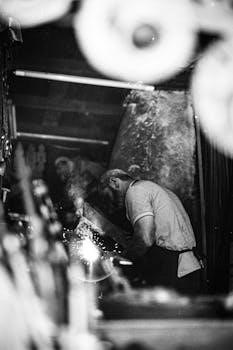Minolta X-700 Instruction Manual⁚ A Comprehensive Guide
Welcome to the comprehensive guide for the Minolta X-700‚ a celebrated 35mm SLR camera. This manual provides essential information for both new and experienced users. Explore features‚ operation‚ and care instructions to maximize your photographic experience with this state-of-the-art camera.
The Minolta X-700‚ introduced in 1981‚ stands as a pinnacle of manual focus 35mm SLR camera design. Celebrated for its blend of user-friendly operation and advanced features‚ the X-700 quickly gained popularity among both amateur and professional photographers. Its enduring legacy is a testament to Minolta’s commitment to quality and innovation in the film photography era.
This camera’s success stemmed from its integration of programmed auto-exposure with aperture-priority modes‚ offering versatile shooting options. The X-700’s electronically controlled shutter‚ coupled with a built-in TTL exposure meter‚ ensures accurate and reliable exposure control. Whether you’re a seasoned film enthusiast or a newcomer to the world of analog photography‚ the X-700 provides a rewarding and creative experience. Its robust build and readily available parts make it a timeless choice for those seeking a classic SLR camera. Familiarizing yourself with this manual will unlock the full potential of your Minolta X-700.
Key Features and Specifications
The Minolta X-700 boasts an array of features that contributed to its widespread acclaim. At its core‚ it utilizes the Minolta MD lens mount‚ offering compatibility with a wide range of high-quality lenses. The camera features an electronically controlled‚ vertical-travel focal-plane shutter‚ providing speeds ranging from 1 second to 1/1000th of a second‚ along with a bulb (B) setting for long exposures.
Exposure control is managed through both programmed auto-exposure and aperture-priority AE modes‚ giving the user flexibility in various shooting scenarios. The built-in TTL exposure meter ensures accurate light readings‚ while the manual focus system allows for precise control over sharpness. The X-700 operates on two readily available S76‚ A76‚ LR44‚ or AG13 batteries. Its weight is approximately 17.5 oz (520g) without a lens. These key features‚ combined with its robust construction‚ make the Minolta X-700 a reliable and versatile tool for photographers of all levels. Understanding these specifications is crucial for optimal camera operation.
Loading and Advancing Film
Proper film loading is essential for capturing memorable moments with your Minolta X-700. Begin by opening the camera back using the rewind knob. Insert the film cartridge into the film chamber‚ ensuring it sits securely. Next‚ draw the film leader across the film plane and insert it into one of the take-up spool slots. Gently advance the film using the film advance lever‚ making sure the film sprockets engage with the corresponding perforations on the film.
Continue advancing the film until the frame counter displays “1.” Close the camera back securely. After closing the camera‚ advance the film twice‚ taking and discarding blank shots‚ to ensure the film is properly positioned for the first exposure. Throughout the process‚ avoid direct sunlight to prevent fogging of the film. Advancing the film after each shot is done using the film advance lever‚ and rewinding the film after the roll is complete is accomplished by releasing the rewind button on the bottom of the camera and using the rewind knob.
Exposure Control⁚ Understanding Aperture and Shutter Speed
Mastering exposure control is crucial for achieving well-balanced and visually appealing photographs with your Minolta X-700. Exposure is determined by two key elements⁚ aperture and shutter speed. Aperture refers to the opening within the lens that allows light to pass through. It’s measured in f-stops (e.g.‚ f/2.8‚ f/8‚ f/16). A wider aperture (smaller f-number) lets in more light‚ creating a shallow depth of field‚ ideal for portraits with blurred backgrounds. A narrower aperture (larger f-number) lets in less light‚ resulting in a greater depth of field‚ suitable for landscapes where everything is in focus.
Shutter speed refers to the amount of time the camera’s shutter remains open‚ exposing the film to light. It’s measured in seconds or fractions of a second (e;g.‚ 1/1000s‚ 1/60s‚ 1s). A fast shutter speed freezes motion‚ perfect for capturing action shots. A slow shutter speed allows more light in and can create motion blur‚ useful for conveying a sense of movement or for shooting in low-light conditions. Balancing aperture and shutter speed is essential for achieving the desired exposure and creative effects.
Metering Modes⁚ TTL Exposure Meter Explained
The Minolta X-700 utilizes a Through-The-Lens (TTL) exposure meter to measure the light entering the camera and provide accurate exposure settings. This system analyzes the light that passes through the lens‚ taking into account the chosen aperture and the sensitivity of the film. The TTL meter offers several advantages‚ including accuracy and consistency across different lenses and shooting conditions.
The X-700’s TTL meter typically operates in a center-weighted average mode. In this mode‚ the meter gives more importance to the light in the center of the frame while also considering the light from the surrounding areas. This is effective for general photography where the main subject is often located in the center. The meter displays its readings through LEDs in the viewfinder‚ indicating whether the scene is overexposed‚ underexposed‚ or properly exposed. Understanding how the TTL meter functions is vital for achieving correctly exposed images‚ especially in challenging lighting situations. By paying attention to the meter’s readings and making appropriate adjustments to aperture or shutter speed‚ you can ensure optimal results.
Using Programmed Auto-Exposure Mode
The Minolta X-700’s Programmed Auto-Exposure (AE) mode offers a convenient and efficient way to capture well-exposed photographs. In this mode‚ the camera automatically selects both the aperture and shutter speed based on the light measured by its internal TTL metering system. This is particularly useful for beginners or in situations where quick shooting is required.

To use Programmed AE mode‚ first‚ set the aperture ring on the lens to the ‘P’ setting. Next‚ ensure the camera is powered on. When you half-press the shutter button‚ the camera’s meter will activate‚ and it will automatically choose the optimal aperture and shutter speed combination for the scene. The selected values are not displayed in the viewfinder in Program mode‚ but the photographer can be assured that the best compromise between sharpness and motion blur has been achieved. Programmed AE mode is suitable for a wide range of photographic situations‚ offering a balance between simplicity and control‚ making it an invaluable tool for capturing spontaneous moments with ease;

Aperture-Priority AE Mode

Aperture-Priority AE mode on the Minolta X-700 gives the photographer control over the aperture while the camera automatically selects the appropriate shutter speed. This mode is ideal for situations where depth of field is a critical factor in the image. By choosing a specific aperture‚ you can control whether the background is blurred (shallow depth of field) or sharp (deep depth of field).
To use Aperture-Priority AE mode‚ set the mode selector dial to the ‘A’ position. Then‚ select your desired aperture using the aperture ring on the lens. When you half-press the shutter button‚ the camera will meter the light and automatically select the shutter speed needed for correct exposure. The selected shutter speed is displayed in the viewfinder‚ allowing you to assess whether it is suitable for your shooting situation. If the shutter speed is too slow‚ you may need to increase the aperture (use a lower f-number)‚ use a faster film speed‚ or stabilize the camera with a tripod to avoid motion blur. Aperture-Priority AE mode empowers you to creatively control the depth of field in your photographs while still relying on the camera for accurate exposure.
Manual Mode Operation
The Minolta X-700’s manual mode provides complete control over both aperture and shutter speed‚ offering the photographer the greatest creative freedom. To engage manual mode‚ set the mode selector dial to the ‘Manual’ position. In this mode‚ the camera’s light meter still provides guidance‚ but you are responsible for setting both the aperture and shutter speed to achieve the desired exposure.
Observe the light meter display in the viewfinder. Adjust the aperture using the aperture ring on the lens and the shutter speed using the shutter speed dial until the meter indicates a correct exposure (typically a needle or LED aligning with a central mark). Remember that you can intentionally overexpose or underexpose the image by deviating from the meter’s recommendation to achieve specific artistic effects. Manual mode is perfect for challenging lighting situations where the camera’s automatic metering might be fooled‚ such as high-contrast scenes or when shooting subjects with unusual reflectivity. Mastering manual mode unlocks the full potential of the Minolta X-700 and empowers you to capture images exactly as you envision them.
Focusing Techniques⁚ Manual Focus and Hyperfocal Scale
The Minolta X-700 relies on manual focusing‚ offering precise control over sharpness. Begin by looking through the viewfinder and locating the focusing ring on your lens. Rotate this ring until your subject appears sharpest in the viewfinder. The X-700 often features a split-image rangefinder or microprism collar in the center of the viewfinder to aid in achieving critical focus. These tools visually indicate when the image is in focus‚ providing a clear reference point.
Beyond standard manual focusing‚ the X-700 also supports the use of the hyperfocal scale. This technique allows you to maximize the depth of field in your images‚ ensuring that everything from a certain distance to infinity appears acceptably sharp. To use the hyperfocal scale‚ locate the distance markings on your lens barrel and align the infinity symbol with the corresponding aperture marking for your chosen f-stop. This will set the focus such that everything from half the hyperfocal distance to infinity is in focus. The hyperfocal scale is particularly useful for landscape photography and situations where you need a wide range of subjects to be sharp.

Flash Photography with the X-700
The Minolta X-700 offers versatile flash photography capabilities‚ allowing you to illuminate your subjects in low-light conditions or add fill light in bright scenes. The camera is compatible with a range of Minolta flashes‚ as well as third-party options. To use a flash‚ attach it to the hot shoe on top of the camera.
The X-700 supports TTL (Through-The-Lens) flash metering‚ providing accurate and automatic flash exposure control. In TTL mode‚ the camera measures the light reflected off the film during the exposure and adjusts the flash output accordingly. To enable TTL flash‚ set the camera to Program (P) or Aperture Priority (A) mode and ensure that the flash is set to TTL mode as well. The X-700 also offers manual flash control‚ allowing you to set the flash output manually for greater creative control. In manual mode‚ you’ll need to calculate the appropriate flash output based on the guide number of the flash‚ the distance to the subject‚ and the aperture setting. Consult your flash’s manual for guidance on manual flash calculations.
Troubleshooting Common Issues
Even with its robust design‚ the Minolta X-700 can sometimes encounter issues. One common problem is a dead or weak battery‚ which can prevent the camera from operating correctly. If the camera doesn’t power on‚ or the meter doesn’t function‚ replace the batteries with fresh ones. Ensure they are inserted with the correct polarity.
Another potential issue is film loading errors. If the film doesn’t advance properly‚ double-check that the film leader is correctly inserted into the take-up spool. Ensure the film is engaged with the sprocket teeth. If the shutter release is locked‚ it could be due to the camera being in multiple exposure mode. Make sure to disengage this. Metering inaccuracies can also occur. Verify that the ISO setting matches the film speed. Clean the lens contacts. If problems persist‚ consider having the camera professionally serviced.
Erratic shutter speeds or a malfunctioning shutter can also occur. This often indicates a need for professional servicing‚ as the shutter mechanism may require cleaning or repair. Remember to consult the full manual for more detailed troubleshooting steps.
Care and Maintenance of Your Minolta X-700
Proper care and maintenance are crucial for prolonging the life of your Minolta X-700. Always store the camera in a cool‚ dry place when not in use‚ away from direct sunlight and extreme temperatures. Use a soft‚ lint-free cloth to gently clean the camera body and lens. Avoid using harsh chemicals or solvents‚ as these can damage the finish and internal components.
Regularly inspect the lens for dust‚ fingerprints‚ or smudges. Use a lens cleaning solution and a microfiber cloth to clean the lens elements. When changing lenses‚ ensure the camera is turned off to prevent electrical damage. Protect the lens with a UV filter to guard against scratches and debris. Periodically check the battery compartment for corrosion. Clean the contacts with a cotton swab if necessary.
If you live in a humid environment‚ consider storing the camera with a desiccant to prevent moisture buildup. Have the camera professionally serviced every few years to ensure optimal performance. A qualified technician can clean and lubricate the internal mechanisms‚ ensuring smooth operation and accurate metering.
